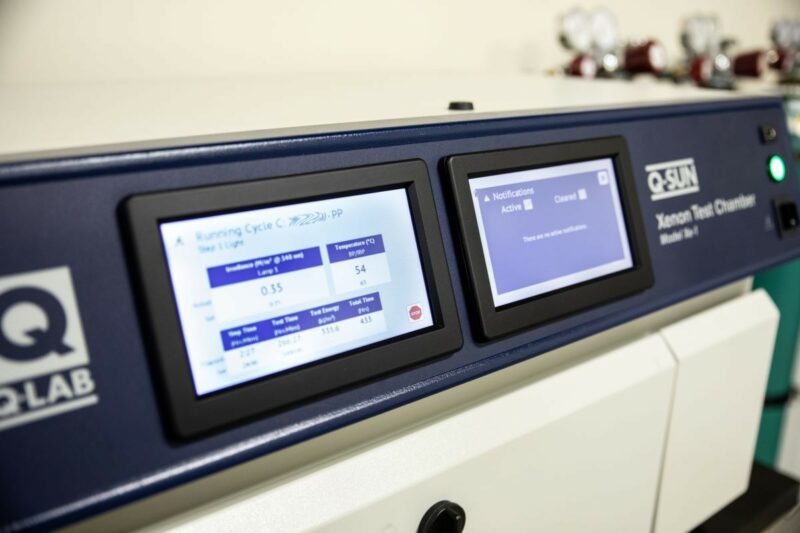Imagine, after nearly two years of hard work, extensive testing, and various design iterations your new product has hit the market. There is nothing quite as exhilarating as creating a new product that will help make people’s lives better. Unfortunately, your joy is short lived as the negative consumer feedback and product returns begin to build and your company’s reputable brand begins to tarnish.
Engaging the failure analysis experts at The Madison Group led to some important discoveries for you and your team. The component leading to the field failures experienced significant deformation during normal operation. How could this be? After all, you performed life testing on the product constructed from production parts! The Madison Group determined that the root cause of the issue was that the plastic material used in the component from the field failures had very different thermal behavior than the material initially used in the component during the product testing phase.
The plastic material that had been selected for this component was a blend of nylon 6 and nylon 6/6 resins. It was called out on the drawing using its specific tradename and grade. To their benefit, the injection molding supplier was using the material specified. But what neither the injection molding manufacturer nor product development company understood was that the resin supplier allowed for significant lot to lot variation in the nylon 6 and nylon 6/6 content in the compounding of the resin. Nylon 6 has a melting point of around 215 °C while nylon 6/6 has a melting point approximately 50 °C higher at 265 °C. Therefore, a resin lot with more nylon 6 content would be expected to have much lower thermal stability than a lot with more nylon 6/6 content.
Over the years, The Madison Group has witnessed similar scenarios happen repeatedly across a variety of products and industries. It is not just an issue of variation in performance specific to resin blends. These types of issues can happen when any ingredient within the resin formulation varies including additives, base resin feedstocks, glass fiber or mineral filler content. Begging the question, what can be done to prevent this?

Xenon weathering chamber.
One option is do not specify the trade name and grade of a plastic material on a component drawing. Instead reference a well-defined material performance specification. Such a specification is focused on how the plastic material needs to behave in the application in order to perform successfully. Some examples of this behavior would include short term performance criteria, like strength and stiffness at elevated temperature, flammability, subambient impact strength and electrical properties including dielectric strength. The specification should also include long-term performance criteria like strength, stiffness, and impact resistance following extended elevated temperature, UV, or chemical exposure, to name only a few.
The accurate ability to capture key material requirements for your application in the form of a specification is critical. If the specification developed is not adequate, then the materials that will be qualified to it will most likely be inadequate as well. This is where experts in material science and selection can help.
Once a robust performance-based material specification is created, material candidates that meet the specification requirements can be proposed. These candidates might include an assortment of grades from a variety of material suppliers and is the beginning of the material qualification process. The objective this process is to ensure that the candidates proposed by the material supplier meets the requirements established in the specification. In most cases, it involves the material supplier providing the customer with multipoint datasets demonstrating that their material candidate will meet the specification requirements for multiple, unique lots of resin. Once such data has been provided the customer can approve the material for consideration in products and components associated with the specification. It is up to the customer to specify how often they would like to require their material suppliers to supply data for the continued approval of their material. This ongoing submission of data demonstrating that the material continues to meet the specification requirements is important to confirm the quality of the material its continued success in the application.

Elevated temperature tensile testing.
Performance-based material specifications also have the potential to increase the number of suppliers and possible materials allowing for more competitive pricing. Calling out a specific tradename and grade on your drawing is great for the material supplier and them alone. Let’s take for instance OmniPro™ HPP GRC30 resin. There is only one resin with this tradename and grade that is available from two different distributors. Keep in mind that there are over 150 injection molding grades of 30% glass fiber reinforced polypropylene resin available in North America alone. However, one needs to ensure that these alternative grades will perform successfully in the application. Relying on product testing to verify the performance of an alternative material can be costly for a company and even eclipse any material cost savings that can be realized on a product. Comparing the material datasheets, which report only single point, short term properties, do not reflect the long term, lot to lot performance of a material. Nor do they capture all your application requirements. Depending instead on performance-based material specifications that have captured the key requirements of the application improve confidence in an alternative material and can also limit the necessary product testing which can result in greater economic gain.
Having your plastic materials well characterized for your application by way of performance-based material specifications also makes it more straight forward to select a material for your application when your requirements change. For instance, your next generation product with see even higher temperature, new chemical exposures, increased stresses, etc… By modifying an existing specification to consider these new or increases requirements the appropriateness of the existing plastic material can easily be evaluated along with potential alternatives. As a result, the number of design iterations needed are reduced, and confidence is higher when product testing begins.
In product development, a lot of time is spent selecting the right materials and validating those choices through product testing. That hard work and success can be preserved through the use of performance-based material specifications and the material qualification process that ensues. Quality does not have to suffer to offer your supplier material flexibility or your purchasing group cost savings opportunities. These specifications can also shorten your go to market timeline when developing your next generation product by reducing the number of design and testing iterations.
